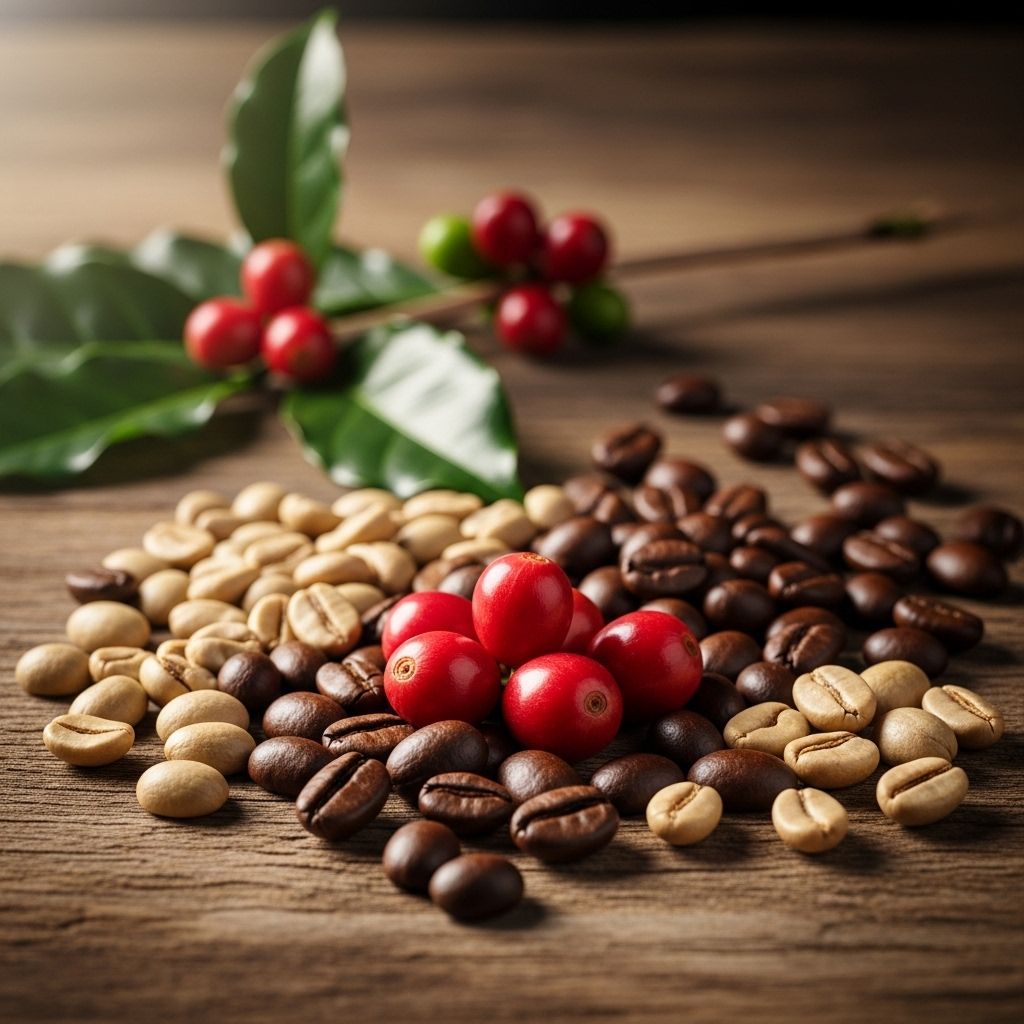Exploring the World of Coffee Beans: Benefits, Uses, and Taste
Discover the rich world of coffee beans and their diverse impacts on health, taste, and culture.

Introduction to Coffee Beans
Coffee beans are one of the most widely consumed food products globally, serving as the primary ingredient for coffee, a beverage enjoyed by millions. Despite their name, coffee beans are not beans but rather seeds from the coffee plant, specifically the fruit known as a coffee cherry. Each cherry typically contains two seeds, which are what we commonly refer to as coffee beans. This article will delve into the composition of coffee beans, their benefits, uses, and the nuances of their taste.
Chemical Composition of Coffee Beans
Coffee beans are complex in composition, with a significant portion consisting of carbohydrates, which account for about 60% of their weight. These carbohydrates include sucrose, pectin, starch, and various types of cellulose and hemicellulose. Other key components include proteins, fats, caffeine, tannins, minerals, and trace elements like chlorogenic acids and trigonelline. The exact composition can vary based on factors such as the coffee species, growing conditions, and processing methods.
Key Components of Coffee Beans:
- Carbohydrates: Primary component, including sucrose, starch, and cellulose.
- Proteins: Around 13%, contributing to the structure and flavor of coffee.
- Fats and Lipids: Present in smaller amounts, contributing to the coffee’s flavor and aroma.
- Caffeine: A significant component, known for its stimulating effect.
- Minerals and Trace Elements: Including potassium, magnesium, and chlorogenic acids.
Benefits of Coffee Beans
Coffee beans offer numerous health benefits, primarily due to their chemical composition. Caffeine is well-known for its ability to enhance alertness and energy, while chlorogenic acids have been studied for their potential weight management and antioxidant properties. Additionally, coffee consumption has been linked to improved cognitive function, reduced risk of certain diseases like type 2 diabetes, and some neuroprotective effects.
Health Benefits of Coffee Consumption:
- Cognitive Function: Enhances alertness and focus.
- Physical Performance: Can improve muscle contraction force and endurance.
- Disease Prevention: May reduce the risk of type 2 diabetes, certain cancers, and cardiovascular diseases.
- Weight Management: Chlorogenic acids may contribute to weight loss.
Uses of Coffee Beans
Beyond their role in brewing coffee, coffee beans can be used in various culinary and medicinal applications. Green coffee beans, specifically, are sometimes used as dietary supplements due to their high chlorogenic acid content. Additionally, coffee beans are used in traditional medicine for their potential health benefits, and they are a key ingredient in many coffee-based products like espresso, lattes, and cappuccinos.
Culinary and Medicinal Uses of Coffee Beans:
- Supplements: Green coffee beans are used for their potential health benefits.
- Cosmetics: Coffee is sometimes used in skincare products for its antioxidant properties.
- Coffee-Based Products: Espresso, latte, cappuccino, cold brew, and other specialized coffee drinks.
Taste and Flavor of Coffee Beans
The taste and flavor of coffee beans are highly variable and depend on several factors, including the coffee species, processing methods, roasting techniques, and brewing methods. Arabica and Robusta are the two main species of coffee beans, with Arabica generally considered to have a more delicate flavor and Robusta a bolder, harsher taste. The roasting process significantly impacts the final flavor profile, with lighter roasts retaining more of the coffee’s natural acidity and fruit notes, while darker roasts produce a richer, more bitter taste.
Factors Influencing Coffee Taste:
- Species: Arabica vs. Robusta, with distinct flavor profiles.
- Roast Level: Lighter roasts are more acidic, while darker roasts are smoother and more bitter.
- Brewing Method: Different methods can highlight or mute various flavor notes.
Frequently Asked Questions (FAQs)
Q: What is the difference between Arabica and Robusta coffee beans?
A: Arabica beans are known for their delicate flavor and higher acidity, while Robusta beans are bolder and contain more caffeine.
Q: How does roasting affect the flavor of coffee beans?
A: Roasting transforms the natural precursors in coffee beans into the complex flavors and aromas we experience. Lighter roasts preserve more acidity and fruit notes, while darker roasts are more bitter and rich.
Q: What health benefits can be attributed to coffee consumption?
A: Coffee consumption is linked to improved cognitive function, reduced risk of certain diseases, and potential weight management benefits.
Conclusion
In conclusion, coffee beans are a fascinating world of complex chemical composition, diverse health benefits, rich culinary uses, and nuanced flavors. Whether you appreciate the art of brewing a perfect cup or seek the health advantages of coffee, understanding the intricacies of coffee beans opens up a world of possibilities for both enjoyment and well-being.
References
- https://pmc.ncbi.nlm.nih.gov/articles/PMC8704863/
- https://en.wikipedia.org/wiki/Coffee_bean
- https://cmsale.com/news/inside-the-bean-what-happens-during-coffee-roasting
- https://www.greenplantation.com/a/chemical-composition-of-coffee
- https://stonestreetcoffee.com/blogs/brooklyn-coffee-academy/coffee-bean-anatomy-101
- https://www.jmreda.com/news/140/
Read full bio of Sneha Tete












